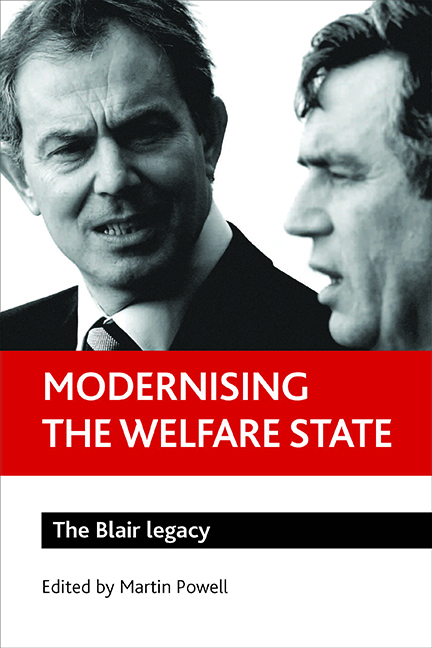Book contents
- Frontmatter
- Contents
- List of tables and figures
- Acknowledgements
- Notes on contributors
- one Introduction: modernising the welfare state
- two The NHS after 10 years of New Labour
- three Housing policy: coming in out of the cold?
- four Social security and welfare reform
- five Social care under Blair: are social care services more modern?
- six Education: from the comprehensive to the individual
- seven Controlling crime and disorder: the Labour legacy
- eight Social investment: the discourse and the dimensions of change
- nine Risk and the Blair legacy
- ten Going private?
- eleven Choice in public services: ‘no choice but to choose!’
- twelve The conditional welfare state
- thirteen The stages of New Labour
- fourteen Social Democratic reforms of the welfare state: Germany and the UK compared
- fifteen Conclusion: the Blair legacy
- Index
- Also available from The Policy Press
six - Education: from the comprehensive to the individual
Published online by Cambridge University Press: 21 January 2022
- Frontmatter
- Contents
- List of tables and figures
- Acknowledgements
- Notes on contributors
- one Introduction: modernising the welfare state
- two The NHS after 10 years of New Labour
- three Housing policy: coming in out of the cold?
- four Social security and welfare reform
- five Social care under Blair: are social care services more modern?
- six Education: from the comprehensive to the individual
- seven Controlling crime and disorder: the Labour legacy
- eight Social investment: the discourse and the dimensions of change
- nine Risk and the Blair legacy
- ten Going private?
- eleven Choice in public services: ‘no choice but to choose!’
- twelve The conditional welfare state
- thirteen The stages of New Labour
- fourteen Social Democratic reforms of the welfare state: Germany and the UK compared
- fifteen Conclusion: the Blair legacy
- Index
- Also available from The Policy Press
Summary
Introduction
A radical programme of reform of education institutions had started before the election of 1997 but was adopted and became the dominating characteristic of Labour's education policy during the three terms of Tony Blair's government. However, the programme was not merely a continuation of the previous government's agenda but an attempt to further transform and modernise the state school system and make it fit for the 21st century (Paterson, 2003). Blair's commitment to ‘education, education, education’ was unrelenting. Every level of pupil and student engagement in schooling, from the early years to post-16, became the target for proposed reform and was subjected to an unprecedented period of change. Most of the changes were of Hall's first or second order as policy instruments altered and settings changed but one area gradually emerged as a paradigm shift and would meet Hall's criterion for a third order change (Hall, 1993). A commitment to comprehensive education, a central feature of the earlier labour manifesto and an aspect of education policy that marked a clear divide between Labour and Conservative policies, was quietly reduced and then abandoned. The debate over selection and the suitability of comprehensive education for all raged through the 1970s and 1980s. By the 1990s and the first decade of the new millennium it became clear that the debate had ended and the comprehensive school as a single type of institution within state provision was to be left behind by the process of modernisation. By the end of the three terms the debate over the comprehensive school model has all but disappeared and the change embedded to the extent that even the Conservative Party has declared ‘no return’ to selection and the grammar school.
The diversification of school types that followed was central to the process of the modernisation of education. Using 6 and Peck's (2004) definition of modernisation as a framework for our analysis of education reforms we can show that perhaps the process of modernisation is more visible in education than in any of the other welfare services. Table 6.1 shows only the key features of this process.
- Type
- Chapter
- Information
- Modernising the Welfare StateThe Blair Legacy, pp. 91 - 104Publisher: Bristol University PressPrint publication year: 2008



